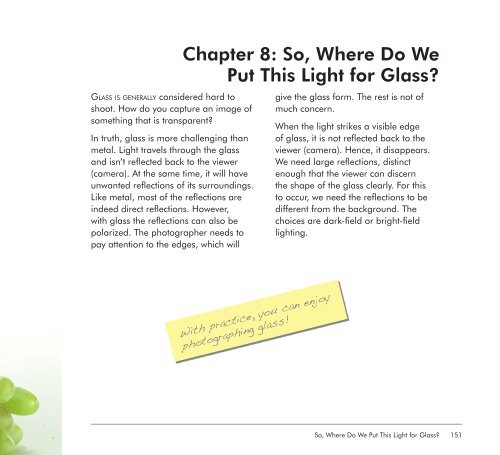Focus On Lighting Photos Focus on the Fundamentals.pdf
Create successful ePaper yourself
Turn your PDF publications into a flip-book with our unique Google optimized e-Paper software.
glass is generally c<strong>on</strong>sidered hard to<br />
shoot. How do you capture an image of<br />
something that is transparent?<br />
In truth, glass is more challenging than<br />
metal. Light travels through <strong>the</strong> glass<br />
and isn’t reflected back to <strong>the</strong> viewer<br />
(camera). At <strong>the</strong> same time, it will have<br />
unwanted reflecti<strong>on</strong>s of its surroundings.<br />
Like metal, most of <strong>the</strong> reflecti<strong>on</strong>s are<br />
indeed direct reflecti<strong>on</strong>s. However,<br />
with glass <strong>the</strong> reflecti<strong>on</strong>s can also be<br />
polarized. The photographer needs to<br />
pay attenti<strong>on</strong> to <strong>the</strong> edges, which will<br />
Chapter 8: So, Where Do We<br />
Put This Light for Glass?<br />
With practice, you can enjoy<br />
photographing glass!<br />
give <strong>the</strong> glass form. The rest is not of<br />
much c<strong>on</strong>cern.<br />
When <strong>the</strong> light strikes a visible edge<br />
of glass, it is not reflected back to <strong>the</strong><br />
viewer (camera). Hence, it disappears.<br />
We need large reflecti<strong>on</strong>s, distinct<br />
enough that <strong>the</strong> viewer can discern<br />
<strong>the</strong> shape of <strong>the</strong> glass clearly. For this<br />
to occur, we need <strong>the</strong> reflecti<strong>on</strong>s to be<br />
different from <strong>the</strong> background. The<br />
choices are dark-field or bright-field<br />
lighting.<br />
So, Where Do We Put This Light for Glass?<br />
151



